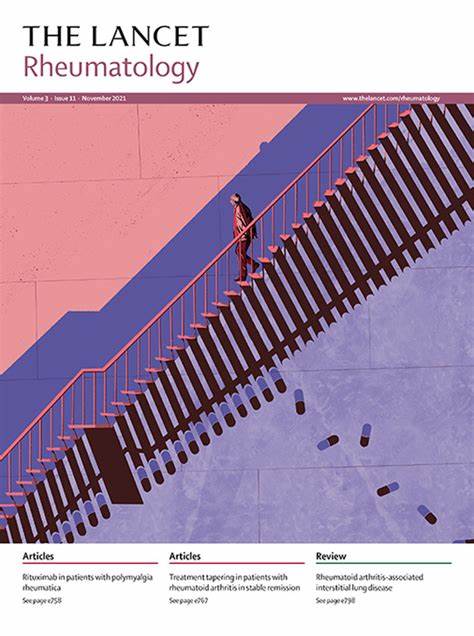Pregnancy outcome predictors in systemic lupus erythematosus: a systematic review and meta-analysis
IF 15
1区 医学
Q1 RHEUMATOLOGY
引用次数: 0
Abstract
Background
To enhance patient-tailored preconception risk assessment for women with systemic lupus erythematosus (SLE), knowledge on risk factors associated with adverse pregnancy outcomes is required. Therefore, we did a systematic review and meta-analysis to identify and provide unambiguous effect sizes of preconception predictors of pregnancy outcomes in women with SLE.
Methods
In this systematic review and meta-analysis, we searched PubMed and Embase for studies reporting preconception predictors of pregnancy outcomes in women with SLE, from database inception to Aug 22, 2023. Studies were included if they presented original, quantitative data on pregnant women with SLE and reported on preconception risk factors on at least one of the outcomes as defined in the protocol. Studies were excluded if they had a sample size of less than 20 patients, were restricted to multiple pregnancies, had unclear timing of prognostication, or exclusively reported a composite outcome. Literature screening, data extraction, and risk-of-bias assessment (quality in prognostic studies tool) were done by two reviewers independently, in a blinded, standardised manner. The reported outcomes included livebirth, pre-eclampsia, small for gestational age, preterm birth, pregnancy loss before and after 20 weeks of gestation, and SLE flares. We computed pooled univariate odds ratios (ORs) and 95% CIs using a random effects model. We assessed heterogeneity using the I2 statistic and prediction intervals. This study is registered with PROSPERO, CRD42022344732.
Findings
Of the 6705 unique articles identified, 72 (1·1%) were included in the meta-analysis, comprising 10 355 pregnancies in 8065 women with SLE. One potentially eligible study was retracted and therefore removed from our analysis. Previous lupus nephritis was associated with decreased livebirth probability (OR 0·62 [95% CI 0·47–0·81]; I2=0%), increased risk of preterm birth (2·00 [1·55–2·57]; I2=17%), and increased risk of pre-eclampsia (3·11 [2·35–4·12]; I2=0%). Chronic hypertension was associated with increased risk of disease flare (2·50 [1·74–3·58]; I2=0%), preterm birth (2·65 [1·87–3·77]; I2=0%), and pre-eclampsia (5·86 [3·41–10·06]; I2=33%). SLE disease activity at conception or preconception was associated with increased risk of preterm birth (2·91 [1·96–4·33]; I2=21%) and pre-eclampsia (2·32 [1·40–3·83]; I2=0%). Secondary antiphospholipid syndrome was associated with decreased livebirth probability (0·40 [0·27–0·58]; I2=0%), increased risk of pregnancy loss after 20 weeks of gestation (2·77 [1·44–5·31]; I2=0%), and increased risk of preterm birth (1·65 [1·29–2·11]; I2=0%). Across studies, risk-of-bias assessment suggested considerable bias in study attrition and confounding.
Interpretation
We identified previous lupus nephritis, chronic hypertension, SLE disease activity before and at conception, and secondary antiphospholipid syndrome as predictors of adverse pregnancy outcomes in women with SLE. These findings contribute to an optimal patient-tailored risk assessment in preconception counselling.
Funding
None.
系统性红斑狼疮妊娠结局预测因素:系统回顾和荟萃分析。
背景:为了加强对患有系统性红斑狼疮(SLE)的妇女进行适合患者的孕前风险评估,我们需要了解与不良妊娠结局相关的风险因素。因此,我们进行了一项系统综述和荟萃分析,以确定系统性红斑狼疮女性患者孕前妊娠结局预测因素的效应大小,并提供明确的效应大小:在这项系统性综述和荟萃分析中,我们检索了 PubMed 和 Embase 中从数据库建立到 2023 年 8 月 22 日期间报告系统性红斑狼疮女性患者妊娠结局孕前预测因素的研究。如果这些研究提供了关于系统性红斑狼疮孕妇的原始定量数据,并报告了方案中定义的至少一种妊娠结局的孕前风险因素,则被纳入研究。样本量少于 20 名患者、仅限于多胎妊娠、预后时间不明确或仅报告综合结果的研究将被排除在外。文献筛选、数据提取和偏倚风险评估(预后研究质量工具)由两名审稿人以盲法和标准化方式独立完成。所报告的结果包括活产、先兆子痫、胎龄小、早产、妊娠20周前后的妊娠损失以及系统性红斑狼疮复发。我们使用随机效应模型计算了汇总的单变量几率比(OR)和 95% CI。我们使用 I2 统计量和预测区间评估了异质性。本研究已在 PROSPERO 注册,编号为 CRD42022344732:在已识别的 6705 篇文章中,有 72 篇(1-1%)被纳入荟萃分析,包括 8065 名系统性红斑狼疮妇女的 10 355 次妊娠。一项可能符合条件的研究被撤回,因此从我们的分析中剔除。曾患狼疮肾炎与活产概率降低(OR 0-62 [95% CI 0-47-0-81];I2=0%)、早产风险增加(2-00 [1-55-2-57];I2=17%)和先兆子痫风险增加(3-11 [2-35-4-12];I2=0%)有关。慢性高血压与疾病复发风险增加(2-50 [1-74-3-58];I2=0%)、早产(2-65 [1-87-3-77];I2=0%)和先兆子痫(5-86 [3-41-10-06];I2=33%)有关。受孕时或受孕前的系统性红斑狼疮疾病活动与早产(2-91 [1-96-4-33];I2=21%)和先兆子痫(2-32 [1-40-3-83];I2=0%)风险增加有关。继发性抗磷脂综合征与活产概率降低(0-40 [0-27-0-58];I2=0%)、妊娠 20 周后妊娠失败风险增加(2-77 [1-44-5-31];I2=0%)和早产风险增加(1-65 [1-29-2-11];I2=0%)有关。在所有研究中,偏倚风险评估表明,在研究减员和混杂方面存在相当大的偏倚:我们发现狼疮肾炎、慢性高血压、受孕前和受孕时的系统性红斑狼疮疾病活动以及继发性抗磷脂综合征是系统性红斑狼疮妇女不良妊娠结局的预测因素。这些发现有助于在孕前咨询中对患者进行最佳的风险评估:无。
本文章由计算机程序翻译,如有差异,请以英文原文为准。
求助全文
约1分钟内获得全文
求助全文
来源期刊

Lancet Rheumatology
RHEUMATOLOGY-
CiteScore
34.70
自引率
3.10%
发文量
279
期刊介绍:
The Lancet Rheumatology, an independent journal, is dedicated to publishing content relevant to rheumatology specialists worldwide. It focuses on studies that advance clinical practice, challenge existing norms, and advocate for changes in health policy. The journal covers clinical research, particularly clinical trials, expert reviews, and thought-provoking commentary on the diagnosis, classification, management, and prevention of rheumatic diseases, including arthritis, musculoskeletal disorders, connective tissue diseases, and immune system disorders. Additionally, it publishes high-quality translational studies supported by robust clinical data, prioritizing those that identify potential new therapeutic targets, advance precision medicine efforts, or directly contribute to future clinical trials.
With its strong clinical orientation, The Lancet Rheumatology serves as an independent voice for the rheumatology community, advocating strongly for the enhancement of patients' lives affected by rheumatic diseases worldwide.
 求助内容:
求助内容: 应助结果提醒方式:
应助结果提醒方式:


